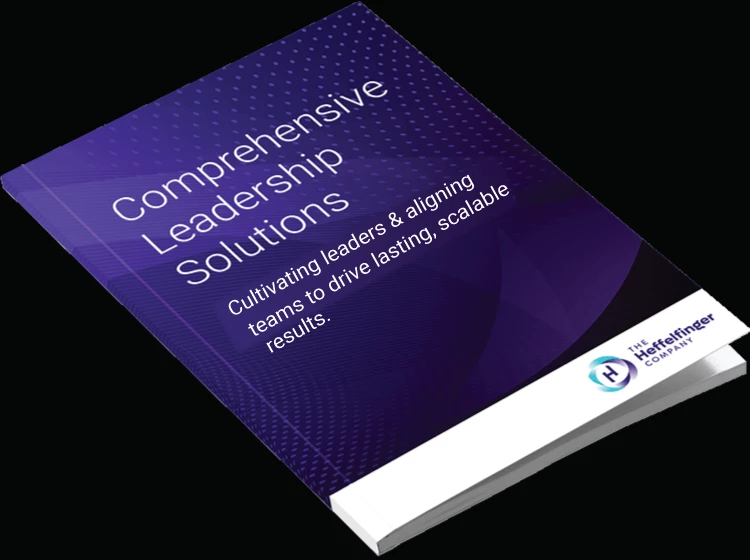“When you change the way you look at things, the things you look at change.” ~ Wayne Dyer
360-degree assessments, also known as multi-rater or multisource feedback, are tools commonly used by leaders to get a comprehensive view of their strengths, development areas, and the needs and expectations others have of the leader/their role. When used well, they can be powerful sources of information for the leader about their leadership style, organization/cultural expectations, and how best to support those around them.
Unlike standard feedback from a single source, 360-degree feedback takes in comments from peers and reporting staff members in addition to supervisors and managers. This strategy helps workers understand their strengths and weaknesses from various perspectives. The advantages of 360-degree feedback include drawing on many different sources, strengthening teamwork, and uncovering procedural issues that might otherwise go unnoticed.
At the Heffelfinger Company, we use several forms of 360 tools, including Qualitative Stakeholder Interviews, Shift Positive 360, and Leadership Circle Profile. In this blog, we will feature the benefits of using Shift Postiive®.
What is Shift Positive®?
Shift Positive® method is a new and unique way of gathering and giving feedback grounded in positive psychology and engaging the leader's "people system" as allies who actively and openly support the leader's development throughout the change process.
This kind of feedback is entirely different and more effective and can have far-reaching effects on organizations, especially during this time of uncertainty, complexity, and even burnout.
Shift Positive® 360 uses:
- Appreciative questions to understand the best of what is.
- Solution-focused questions to identify specific desired behaviors.
- Systems thinking to garner allies from the leader's "people system."
- Social network analysis to gain insight into energy-raising behaviors and energy zappers
Overall, this process is about more than just the individual leader receiving feedback. It is about creating an environment conducive to the leader's progress and engagement, creating fertile soil for growth.
Shift Positive® 360 creates deeper, lasting change, faster, with more dialogue, disclosure, and depth of thought by all participants — all allies in each other's success.
- Increased Positive Action: Instead of focusing on the weaknesses and asking the leader to do less of something, Shift Positive® 360 focuses on the strengths to find what the leader can do more of. This shift helps individuals be more effective.
- Reduces Ambiguity: Providing specific, solution-focused contextual examples that outline a desired future.
- Improved relationships: Creating two-way open and transparent support within the organization, recognizing development needs, and reinforcing positive forward-focused actions.
- Developing allyship: By directly asking the respondents how they can support the leader in particular growth areas, the respondents are invited to be the leader’s ally, leading to more support throughout the organization.
“Transform your organization through positive psychology and social support“ ~ Peter Berridge and Jen Ostrich
With 360 assessments, there are some mistakes you avoid some common mistakes.
360 Assessment Mistakes
360 assessments can be valuable tools for personal and professional development, but we need to avoid some common mistakes when conducting them.
Here are a few examples:
- Focusing too much on the negative: It's easy to get caught up in negative feedback and forget to acknowledge positive feedback, which can lead to demotivation and hinder progress. It's essential to focus on both strengths and weaknesses and use the feedback constructively.
- Overfocusing on anonymity: When we don't know how to say something constructively, we often say it confidentially. The Shift Positive® method ensures the tough feedback is framed constructively and productively, so it is neither confidential nor anonymous. (This is unique in 360 feedback approaches, where most ensure the rater’s or interviewee's anonymity). It's important that the leader knows the context of the feedback. Further, each participant becomes an ally of the leader to support them in their growth.
- Preparing the leader to receive feedback: Receiving feedback can be difficult and overwhelming; without preparing the leader to receive it can make matters worse. It's essential to prepare the feedback receiver and provide support to help them process and implement the feedback. We always present the “good stuff” first to condition the leader to hear what other people think of them and to acknowledge that the feedback is contextual (this organization, this culture, this set of people, at this time).
- Survey results without creating an action plan: We have seen where leaders receive their 360 survey results without a debrief and support to create an action plan. 360 assessments are most effective when the leader develops a personalized development plan based on the feedback. The Shift Positive® method not only builds in a development plan but also includes references to the new allies in the organization as go-to people for the leader.
Conclusion:
360 Assessments are valuable tools in any organization's Leader and Executive Development tool kit. They can give the leader insight into their organization, its culture, and the expectations of those around them. They are powerful tools that need to be used judiciously and with care. We like Shift Positive® for Leader and Executive development because of its positive focus, lack of anonymity, and powerful allyship building.
If you want to learn more about 360 assessments and Shift Positive®, get in touch with us.
Warmly,
James and Lori
James Jackman and Lori Heffelfinger







